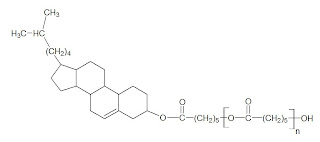Hydrophobic surface eroding polyesters available
Due to popular demand PolySciTech has begun marketing hydrophobic polyesters which encourage surface eroding profiles rather than bulk degradation which typifies traditional polyesters like PLGA (for a detailed explanation of bulk vs. surface eroding see an excellent review article Uhrich et. al. 1999 full text here). To encourage surface erosion emphasis is placed on hydrophobicity so as to discourage water permeation into the matrix for the following polymers.
Cat: AP96 Name: Poly(caprolactone)-cholesterol endcap polymer (Mn: 25,000-35,000 Da)
PCL is fairly hydrophobic to begin with but the addition of bulky, hydrophobic cholesterol endcap further discourages water permeation. Dissolves easily in organic solvents such as dichloromethane for processability.
(nominal mass ratio succinate:butylene:lactide: 54:26:20)
Poly(butylene succinate) PBS is already known to be primarily surface eroding
(http://www.plaza1.snu.ac.kr/~fpbk21/master/subject/Download/Seoul_20060829190827.pdf)
and has been shown to have biocompatibility (http://beyotime.com/reference/c0038-ref7.pdf) however processing is limited due to solubility problems. AO36 is a random copolymer of the succinate/butylene along with lactide so as to render the polymer matrix as a whole soluble in DCM while still retaining the hydrophobicity of the PBS.


No comments:
Post a Comment